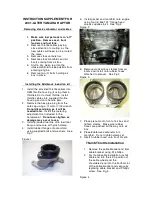
area of the interference, the system auto-
matically becomes active again.
Declaration according to NHTSA/
FMVSS 138 Tire Pressure Monitoring
System
Each tire, including the spare (if provided)
should be checked monthly when cold and in-
flated to the inflation pressure recommended
by the vehicle manufacturer on the vehicle
placard or tire inflation pressure label. (If your
vehicle has tires of a different size than the
size indicated on the vehicle placard or tire in-
flation pressure label, you should determine
the proper tire inflation pressure for those
tires.) As an added safety feature, your vehicle
has been equipped with a tire pressure moni-
toring system (TPMS) that illuminates a low
tire pressure telltale when one or more of your
tires is significantly under-inflated. Accordingly,
when the low tire pressure telltale illuminates,
you should stop and check your tires as soon
as possible, and inflate them to the proper
pressure. Driving on a significantly under-in-
flated tire causes the tire to overheat and can
lead to tire failure. Under-inflation also reduces
fuel efficiency and tire tread life, and may affect
the vehicle's handling and stopping ability.
Please note that the TPMS is not a substitute
for proper tire maintenance, and it is the driv-
er's responsibility to maintain correct tire pres-
sure, even if under-inflation has not reached
the level to trigger illumination of the TPMS
low tire pressure telltale. Your vehicle has also
been equipped with a TPMS malfunction indi-
cator to indicate when the system is not oper-
ating properly. The TPMS malfunction indica-
tor is combined with the low tire pressure
telltale. When the system detects a malfunc-
tion, the telltale will flash for approximately one
minute and then remain continuously illumi-
nated. This sequence will continue upon sub-
sequent vehicle start-ups as long as the mal-
function exists. When the malfunction indicator
is illuminated, the system may not be able to
detect or signal low tire pressure as intended.
TPMS malfunctions may occur for a variety of
reasons, including the installation of replace-
ment or alternate tires or wheels on the vehicle
that prevent the TPMS from functioning prop-
erly. Always check the TPMS malfunction tell-
tale after replacing one or more tires or wheels
on your vehicle to ensure that the replacement
or alternate tires and wheels allow the TPMS
to continue to function properly.
Flat Tire Monitor
Principle
The system detects tire pressure loss on the
basis of rotation speed differences between
the individual wheels while driving.
In the event of a tire pressure loss, the diame-
ter and therefore the rotational speed of the
corresponding wheel changes. The difference
will be detected and reported as a flat tire.
The system does not measure the actual infla-
tion pressure in the tires.
Functional requirements
The following prerequisites must be met for
the system; otherwise, reliable message of a
tire pressure loss is not assured:
▷
After a tire or wheel change, an initialization
was performed with the correct tire inflation
pressure.
▷
After the tire pressure was adjusted to a
new value, an initialization was performed.
Status display
The current status of the flat tire monitor can
be displayed, e.g., whether the flat tire monitor
is active.
Via iDrive:
1.
"My Vehicle"
2.
"Vehicle status"
3.
"Flat Tire Monitor"
Seite 149
Safety
CONTROLS
149
Online Edition for Part no. 01405A540A1 - II/22
Содержание X2 2022
Страница 1: ...OWNER S MANUAL BMW X2 Content A Z Online Edition for Part no 01405A540A1 II 22...
Страница 2: ......
Страница 231: ...Reducing fuel consumption DRIVING TIPS 231 Online Edition for Part no 01405A540A1 II 22...
Страница 289: ...Appendix REFERENCE 289 Online Edition for Part no 01405A540A1 II 22...
Страница 303: ...BL5A540A1003 01405A540A1 ue Online Edition for Part no 01405A540A1 II 22...
Страница 304: ......
Страница 305: ......
Страница 306: ......
Страница 307: ...California Proposition 65 Warning For vehicles sold in California Online Edition for Part no 01405A540A1 II 22...
















































